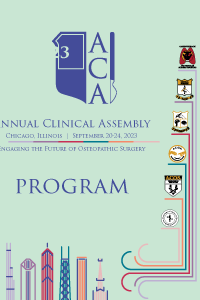Urological Surgery
Assessment of Professional Burnout in Junior and Senior Urology Trainees
- RD
Raeann Dalton, B.S.
Rowan-Virtua School of Osteopathic Medicine
Colonia, New Jersey, United States
Primary Presenter(s)
Burnout is one of the many challenges physicians may face in their careers. Over one third of urological surgeons and nearly half of urological residents are experiencing burnout, with upward trending rates of burnout among urologists since 2016. There is limited understanding of how burnout rates differ throughout each level of urological residency and fellowship training, and what factors are contributing to burnout. The aim of this study is to measure and compare factors contributing to rates of burnout between junior and senior trainees in urological surgery and determine desired changes that may improve work-life balance and wellbeing.
Methods or Case Description:
To assess the rate and factors associated with burnout in urology residents, respondents were categorized into junior trainees (PGY1, PGY2, PGY3) and senior trainees (PGY4, PGY5/6, and Fellow). Respondents completed the 22-item Maslach Burnout Inventory Human Services Survey from the 2019 American Urological Association Annual Census. Respondents were asked to rank the relative importance of six benefits or resources that may be provided to improve well-being and work/life balance. Statistical analysis was performed using chi square tests for categorical variables and t-tests for continuous variables. A total of 512 respondents were included, of which 43% (N=220) were junior trainees and 57% (N=292) were senior trainees. Junior trainees were more likely to be single and younger in age, and less likely to have children than senior trainees. In total, 43% of respondents experienced burnout. The burnout rate was 50% for junior trainees and 38% in senior trainees (p=0.005). In addition, 50% of junior trainees and 38% of senior trainees experienced high levels of depersonalization (p=0.018), while 9% of junior and 5% of senior trainees experienced high levels of emotional exhaustion (p=0.053). Junior trainees were less likely to choose medicine as a career again (81% vs 88%, p=0.030); however, both groups similarly reported low levels of overall specialty regret. When asked to rank changes to improve work-life balance in order of preference, both groups highly ranked access to meal plans, on call rooms, and time to attend health appointments during work hours. Although most urology trainees are satisfied with their decision to go into urology, nearly half of trainees meet criteria for professional burnout. Junior urological trainees in particular experienced higher levels of burnout, depersonalization, and emotional exhaustion when compared to senior trainees. This may be due to factors such as increased hospital responsibility with lower levels of autonomy and overall less time in the operating room. Urology residency programs should prioritize providing meal plans, on-call quarters, and time to attend health appointments during work hours to improve work-life balance among trainees.
Outcomes:
Conclusion:

